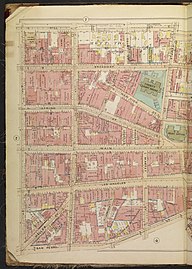
Broadway, until 1890 Fort Street, is a thoroughfare in Los Angeles County, California, United States. The portion of Broadway from 3rd to 9th streets, in the Historic Core of Downtown Los Angeles, was the city's main commercial street from the 1910s until World War II, and is the location of the Broadway Theater and Commercial District, the first and largest historic theater district listed on the National Register of Historic Places (NRHP). With twelve movie palaces located along a six-block stretch of Broadway, it is the only large concentration of movie palaces left in the United States.

The Los Angeles Chinese massacre of 1871 was a racial massacre targeting Chinese immigrants in Los Angeles, California, United States that occurred on October 24, 1871. Approximately 500 white and Latino Americans attacked, harassed, robbed, and murdered the ethnic Chinese residents in what is today referred to as the old Chinatown neighborhood. The massacre took place on Calle de los Negros, also referred to as "Negro Alley". The mob gathered after hearing that a policeman and a rancher had been killed as a result of a conflict between rival tongs, the Nin Yung, and Hong Chow. As news of their death spread across the city, fueling rumors that the Chinese community "were killing whites wholesale", more men gathered around the boundaries of Negro Alley.
Ruben F. Salazar Park is a park in East Los Angeles, Los Angeles County, California. The park, located at 3864 Whittier Boulevard, about 2 miles (3.2 km) east of Downtown Los Angeles, is managed by the Los Angeles County Department of Parks and Recreation.

Dixieland is an unincorporated community in Imperial County, California. The name was likely a reference to the Pima cotton fields in the area. It is located 5 miles (8 km) east of Plaster City on County Route S80, at an elevation of 36 feet below sea level.

Falling Springs is an archaic placename in Los Angeles County, California. Falling Springs was the site of rustic resorts located along the north fork of the San Gabriel River in the San Gabriel Mountains along Soldier Creek, 12 miles (19 km) north-northeast of Azusa, in close proximity to Crystal Lake Recreation Area in the Angeles National Forest.

Mission Acres was a rural community in the northern San Fernando Valley. Its historic boundaries correspond roughly with the former community of Sepulveda and present day community of North Hills within Los Angeles, California. The community's western border was Bull Creek, which flowed south out of Box Canyon in the western San Gabriel Mountains near San Fernando Pass.
George Fall was an American politician. He was a member of the Los Angeles, California, Common Council, the governing body of that city, in 1870–71 and was present when a mob lynched 18 Chinese in the Chinese massacre of 1871.

The California Digital Newspaper Collection (CDNC) is a freely-available, archive of digitized California newspapers; it is accessible through the project's website. The collection contains over six million pages from over forty-two million articles. The project is part of the Center for Bibliographical Studies and Research (CBSR) at the University of California Riverside.
Albert Etter (1872–1950) was an American plant breeder best known for his work on strawberry and apple varieties.

Edward Kern (1860–1912) was a politician and police chief from Los Angeles, California. He also served in the war against Geronimo.

The California Nursery Company was established in Niles, California, and incorporated in 1884 by John Rock, R. D. Fox, and others. The nursery sold fruit trees, nut trees, ornamental shrubs and trees, and roses. It was responsible for introducing new hybrids created by such important West Coast breeders as Luther Burbank and Albert Etter.

The late-Victorian-era Downtown of Los Angeles in 1880 was centered at the southern end of the Los Angeles Plaza area, and over the next two decades, it extended south and west along Main Street, Spring Street, and Broadway towards Third Street. Most of the 19th-century buildings no longer exist, surviving only in the Plaza area or south of Second Street. The rest were demolished to make way for the Civic Center district with City Hall, numerous courthouses, and other municipal, county, state and federal buildings, and Times Mirror Square. This article covers that area, between the Plaza, 3rd St., Los Angeles St., and Broadway, during the period 1880 through the period of demolition (1920s–1950s).

Retail in Southern California dates back to its first dry goods store that Jonathan Temple opened in 1827 on Calle Principal, when Los Angeles was still a Mexican village. After the American conquest, as the pueblo grew into a small town surpassing 4,000 population in 1860, dry goods stores continued to open, including the forerunners of what would be local chains. Larger retailers moved progressively further south to the 1880s-1890s Central Business District, which was later razed to become the Civic Center. Starting in the mid-1890s, major stores moved ever southward, first onto Broadway around 3rd, then starting in 1905 to Broadway between 4th and 9th, then starting in 1915 westward onto West Seventh Street up to Figueroa. For half a century Broadway and Seventh streets together formed one of America's largest and busiest downtown shopping districts.
Lavender Lounge was a public access television show in San Francisco that aired from 1991 to 1995, one of the first of its kind in the United States. Mark Kliem was the creator and executive producer of Lavender Lounge, nicknamed "The Queer American Bandstand". In addition to dancers invited from the general public, Lavender Lounge frequently featured LGBTQ+ artists, drag queens and performers such as the queer punk band Pansy Division, Elvis Herselvis, and the Acid Housewives, the latter of whom the New York Times, reviewing Lavender Lounge, described as " three men in psychedelic-colored housedresses".

The second Los Angeles federal building in Los Angeles County, California, more formally the United States Post Office and Courthouse, was a government building in the United States was designed by James Knox Taylor ex officio and constructed between 1906 and 1910 on the block bounded by North Main, Spring, New High, and Temple Streets. The location was previously known as the Downey Block.

The Los Angeles Union Stock Yards were a livestock market and transfer station in the so-called Central Merchandising District south of downtown Los Angeles in Los Angeles County, California. The stock yards closed in 1960 and the facilities were demolished and replaced with other industrial warehouses.

The first Los Angeles federal building, more formally the Los Angeles Federal Courthouse and Post Office or U.S. Post Office and Custom House was a Richardsonian Romanesque red brick, brownstone and terra cotta structure designed by Will A. Freret. The building, located at the corner of Main Street and Winston Street, between Fourth and Fifth Streets, was used for about nine years, from 1892 to 1901, to house the Southern District of California, a U.S. post office, and the customs office. The building was partially demolished in 1901; Court moved to the Tajo Building in the meantime. The post office was housed at a series of locations until the second Los Angeles federal building opened in 1910.

Fraser's Million Dollar Pier was a 20th-century amusement park in Ocean Park, California in the United States. The pier was located between Pier Avenue and Marine Street, in a community situated between Santa Monica and Venice in Los Angeles County. Developed by A. H. Fraser, a booster in Ocean Park who had formerly been business partners with Abbot Kinney of Venice, the pier opened to the public on June 17, 1911, and was destroyed September 3, 1912, in a catastrophic fire that spread into the adjacent neighborhood and destroyed six to eight square blocks.

The Ship Cafe was a landmark of Venice, California, United States, from 1903 to 1946. Built along the Venice Pier over the water off Windward Avenue, the restaurant and event space was known for its sumptuous food and prestigious clientele. The ship was a novelty building, set on concrete pilings, and not actually a sea-worthy vessel.

















